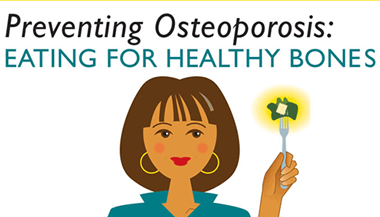Vitamin D and Calcium
What are Vitamin D and Calcium?
Vitamin D (a hormone) and calcium (a mineral) are nutrients that sustain healthy bones. They are also needed for:
-
Muscle movement
-
Nerve communication
-
Absorption of calcium and phosphorous (vitamin D)
-
Immune system responses (vitamin D)
-
Signaling between cells (calcium)
-
Hormonal secretion (calcium)
-
Blood vessel flow (calcium)
Without enough vitamin D or calcium, your parathyroid glands compensate by producing too much of their hormone, a condition called hyperparathyroidism. That can lead to bone weakening (osteoporosis) and increased fracture risk.
Other problems from calcium and vitamin D deficiencies include:
-
Skeletal deformities (rickets) in children ages 6-24 months
-
Muscle weakness in children and the elderly (vitamin D only)
Given the crucial role of both nutrients in bone health, The Endocrine Society and the Institute of Medicine recommend certain consumption levels based on age and health. They have not yet found, however, that taking vitamin D provides cardiovascular protection.
How Much Vitamin D and Calcium Do You Need?
The Endocrine Society and The Institute of Medicine have suggested recommended daily allowances (RDA) for vitamin D and calcium, as well as maximum daily consumption amounts that you should not exceed for your safety:
| Population | Calcium RDA (mg) | Calcium Max (mg) | Vitamin D RDA (IU) | Vitamin D Max (IU) |
|---|---|---|---|---|
| 0-6 months | 200 | 1,000 | 400 | 1,000 |
| 6-12 months | 260 | 1,500 | 400 | 1,500 |
| 1-3 years | 700 | 2,500 | 600 | 2,500 |
| 4-8 years | 1,000 | 2,500 | 600 | 3,000 |
| 9-13 years | 1,300 | 3,000 | 600 | 4,000 |
| 14-18 years | 1,300 | 3,000 | 600 | 4,000 |
| 19-30 years | 1,000 | 2,500 | 600 | 4,000 |
| 31-50 years | 1,000 | 2,500 | 600 | 4,000 |
| 51-70 years male | 1,000 | 2,000 | 600 | 4,000 |
| 51-70 years female | 1,200 | 2,000 | 600 | 4,000 |
| 70+ years | 1,200 | 2,000 | 800 | 4,000 |
| 18 or younger, pregnant/lactating | 1,300 | 3,000 | 600 | 4,000 |
| 19-50, pregnant/lactating | 1,000 | 2,500 | 600 | 4,000 |
The recommendations come with two precautions:
-
Some people may need more than the RDA (after talking with their doctor) if they are:
-
Obese
-
Taking anticonvulsant medications, glucocorticoids, antifungals such as ketoconazole or medications for AIDS
-
-
Taking too much of either nutrient appears to be harmful, with:
-
Kidney stones associated with too much calcium from supplements
-
Very high levels of vitamin D (above 10,000 IUs per day) potentially causing kidney and tissue damage
-
How Do You Get Vitamin D and Calcium?
Your body makes Vitamin D when your skin is exposed to sun, but several factors limit its creation:
-
Living anywhere in the country above latitude 33 degrees (the top of Louisiana)
-
Wearing sunscreen to protect against melanoma
-
Having naturally dark skin
-
Aging, which changes absorption ability
-
The amount of sun you would need to achieve normal blood vitamin D levels is probably more than is safe for your skin, so most people may need supplements to achieve a normal vitamin D level.
Either form of vitamin D (D2 or D3) benefits the body, but very few foods naturally contain the nutrient or are fortified with it. That’s why doctors recommend supplements to make up the difference. Foods containing vitamin D include:
-
Cod liver oil: 400-1,000 IU per teaspoon
-
Wild caught salmon: 600-1,000 IU per 3.5 oz
-
Farmed salmon: 100-250 IU per 3.5 oz
-
Canned salmon: 300-600 IU per 3.5 oz
-
Canned sardines: 300 IU per 3.5 oz
-
Canned mackerel: 250 IU per 3.5 oz
-
Canned tuna: 236 IU per 3.5 oz
-
Fresh shitake mushrooms: 100 IU per 3.5 oz
-
Sundried shitake mushrooms: 1,600 IU per 3.5 oz
-
Egg yolk: 20 IU per yolk
Milk, orange juice, infant formula, yogurt, margarine, butter, cheese and breakfast cereals are often fortified with vitamin D.
Calcium is found in:
-
Dairy products
-
Chinese cabbage
-
Kale
-
Broccoli
-
Fortified fruit juices, drinks, tofu and cereals
Vitamin D Deficiency
A lack of vitamin D can cause serious problems, and doctors typically prescribe larger doses for 6-8 weeks to those with a diagnosed deficiency. Patients should make sure their labs are following Endocrine Society and Institute of Medicine thresholds when getting tested.
Neither group recommends universal screening for a vitamin D deficiency. Certain medical conditions, ethnicities and medications put people at risk and make them candidates for testing:
-
Rickets
-
Osteomalacia
-
Chronic kidney disease
-
Liver failure
-
Malabsorption syndromes
-
Cystic fibrosis
-
Inflammatory bowel disease
-
Bariatric surgery
-
Radiation enteritis
-
-
Medications
-
Anti-seizure medications
-
Glucocorticoids
-
AIDS medications
-
Antifungals like ketoconazole
-
Cholestyramine
-
-
African-American and Hispanic children and adults
-
Pregnant and lactating women
-
Older adults with a history of falls
-
Older adults with a history of fractures
-
Obese children and adults
-
Granuloma-forming disorders
-
Sarcoidosis
-
Histoplasmosis
-
Coccidiomycosis
-
Berylliosis
-
-
Some lymphomas






